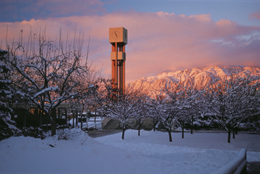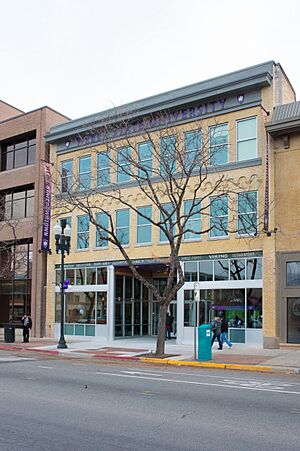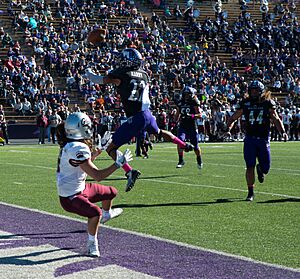Weber State University facts for kids
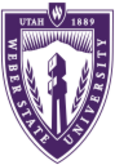 |
|
|
Former names
|
Weber Stake Academy (1889–1902) Weber Academy (1902–1918) Weber Normal College (1918–1922) Weber College (1922–1962) Weber State College (1962–1990) |
|---|---|
| Type | Public university |
| Established | 1889 1964 (as four-year), 1991 (as university) |
|
Parent institution
|
Utah System of Higher Education |
| Accreditation | NWCCU |
|
Academic affiliations
|
CUMU |
| Endowment | $219,555,666 (2022) |
| President | Brad L. Mortensen |
|
Academic staff
|
1,046 |
|
Administrative staff
|
820 |
| Students | 29,914 (fall 2022) |
| Undergraduates | 28,903 (fall 2022) |
| Postgraduates | 1,011 (fall 2022) |
| Location |
,
Utah
,
United States
41°11′35″N 111°56′38″W / 41.193°N 111.944°W |
| Campus | Urban |
| Colors | Purple and white |
| Nickname | Wildcats |
|
Sporting affiliations
|
NCAA Division I FCS Big Sky Conference |
 |
|
Weber State University is a public university located in Ogden, Utah, United States. It was started in 1889 by The Church of Jesus Christ of Latter-day Saints. The university got its current name in 1991.
As of fall 2023, about 30,536 students attended Weber State. This makes it the third-largest public university in Utah. The university offers over 225 different study programs and has 7 main colleges. Weber State is officially recognized by the Northwest Commission on Colleges and Universities.
The university's sports teams are called the Wildcats. They compete in the Big Sky Conference as part of NCAA Division I. This means they play against other large universities.
Contents
History of Weber State
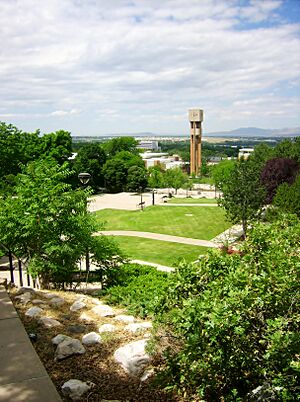
Weber State University began as the Weber Stake Academy in 1889. It was founded by The Church of Jesus Christ of Latter-day Saints. The name "Weber" comes from the county where the university is located. Weber County was named after John Henry Weber, an early fur trader.
The school first opened its doors to 98 students on January 7, 1889. Louis F. Moench was the first principal. Later, David O. McKay also served as principal.
In the early 1900s, the school changed its name several times. It was called Weber Academy in 1902, Weber Normal College in 1918, and Weber College in 1922. By the late 1920s, the college faced money problems. In 1931, the state of Utah decided to take over Weber College.
In 1933, Weber College became a state-supported junior college. This meant it offered the first two years of college education. In 1954, the college moved to its current location in Ogden. It became a four-year college in 1964 and was renamed Weber State College. On January 1, 1991, it officially became Weber State University.
What You Can Study
Weber State University offers more than 225 different programs. These programs lead to certificates or degrees. They are offered through 7 main colleges:
- College of Engineering, Applied Science & Technology
- College of Science
- College of Social & Behavioral Sciences
- Dr. Ezekiel R. Dumke College of Health Professions
- John B. Goddard School of Business & Economics
- Telitha E. Lindquist College of Arts & Humanities
- Jerry & Vickie Moyes College of Education
Campus Locations
Weber State University's main campus is in Ogden, Utah. It is located near the Wasatch Mountains. The Ogden campus is very large, covering over 500 acres. It has 63 buildings and dorms for over 1,000 students.
The Dee Events Center is on campus. It hosts most of the university's indoor sports games. It also holds large community events and performances.
The Val A. Browning Center for the Performing Arts is also on the Ogden campus. It hosts over 200 events each year, welcoming about 70,000 visitors.
Other Campuses and Online Learning
Weber State also has a campus in Layton, Utah, called WSU Davis. This campus offers many services and courses. It is about 20 miles north of Salt Lake City.
The university also has other smaller locations. These include centers in Morgan, Clearfield, and Farmington, Utah. Weber State also offers many courses and degrees online. This allows students to learn from anywhere.
Living on Campus
Students can live in dorms at Wildcat Village on the Ogden campus. There are also apartment-style living options at University Village. These are located near a bus stop, making it easy to get around.
Being Green at Weber State
Weber State University is working to be very environmentally friendly. They have a plan to become "carbon neutral" by 2040. This means they want to balance the carbon they release with the carbon they remove.
Since 2007, Weber State has lowered its greenhouse gas emissions by 34%. This has also saved the university nearly $16 million in energy costs.
Sports and Teams
The university's sports teams are called the Wildcats. They play in the Big Sky Conference as an NCAA Division I school. The school colors are purple and white.
The football team plays at Stewart Stadium on the Ogden campus. The men's and women's basketball teams play at the Dee Events Center. Other sports include track and field, golf, tennis, soccer, volleyball, and softball.
Weber State's Spirit Squad has won six national championships. In 2023, the Wildcat team won the Grand National Championship in their division. They had the best score of any school in the competition.
Students can also join club sports through Campus Recreation. These include archery, baseball, hockey, lacrosse, rugby, and many more.
Student Life
Weber State has a student-run newspaper called The Signpost. It publishes news and events from campus and Ogden City.
The university also has an online radio station called KWCR Wildcat Radio. Students learn how to run a radio station and can even host their own shows.
Metaphor is a magazine that features student writing and art. It has been highlighting student creativity for over 40 years.
Famous People from Weber State
Many successful people have attended or worked at Weber State. Here are a few:
- Nolan D. Archibald – Former CEO of Black & Decker
- H. Tracy Hall – Inventor of the industrial diamond
- Dee Hock - Creator of the Visa credit card
- Damian Lillard – Professional basketball player
- J. Willard Marriott – Famous business leader
- David O. McKay – Past president of the Church of Jesus Christ of Latter-day Saints
- Wataru Misaka – Professional basketball player
- Dick Motta – Professional basketball coach
- Jerry Moyes - Founder of Swift Transportation
- Sarah Sellers – Marathon runner
Images for kids


